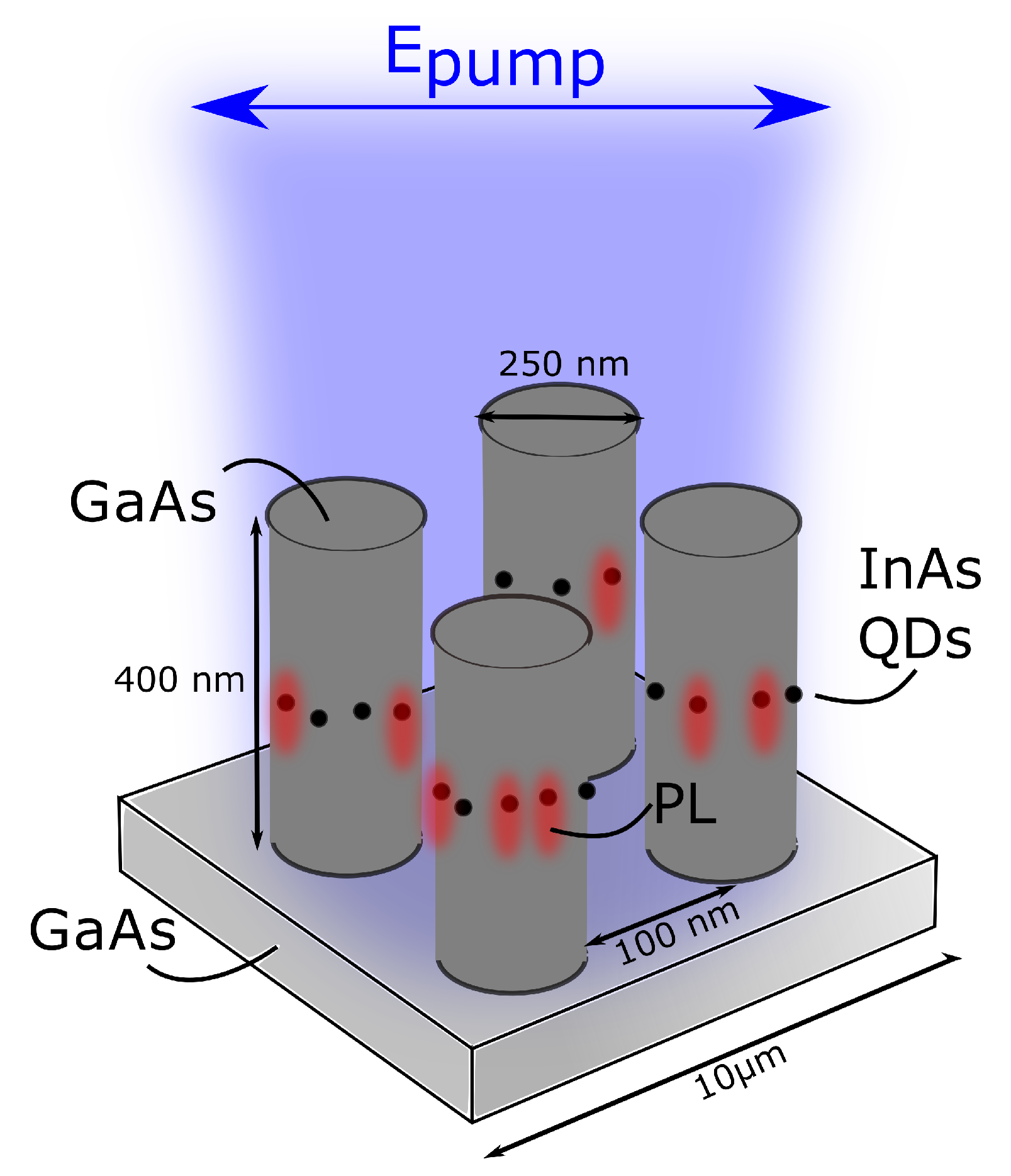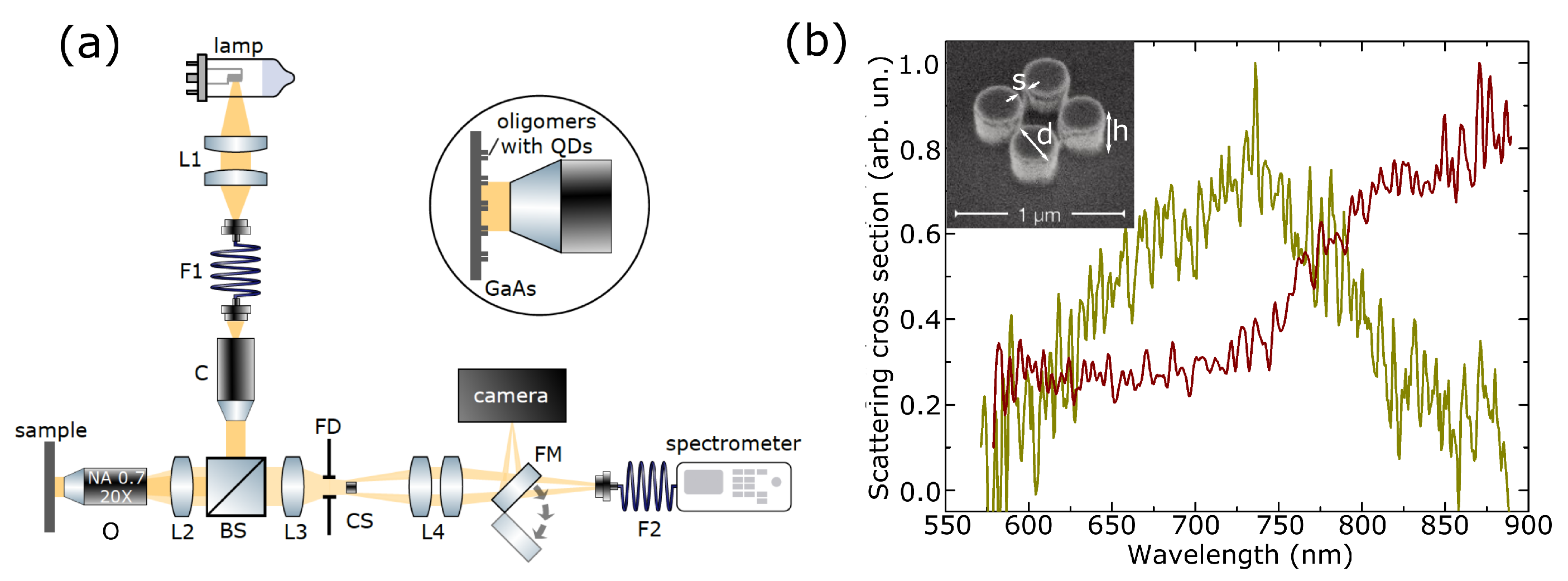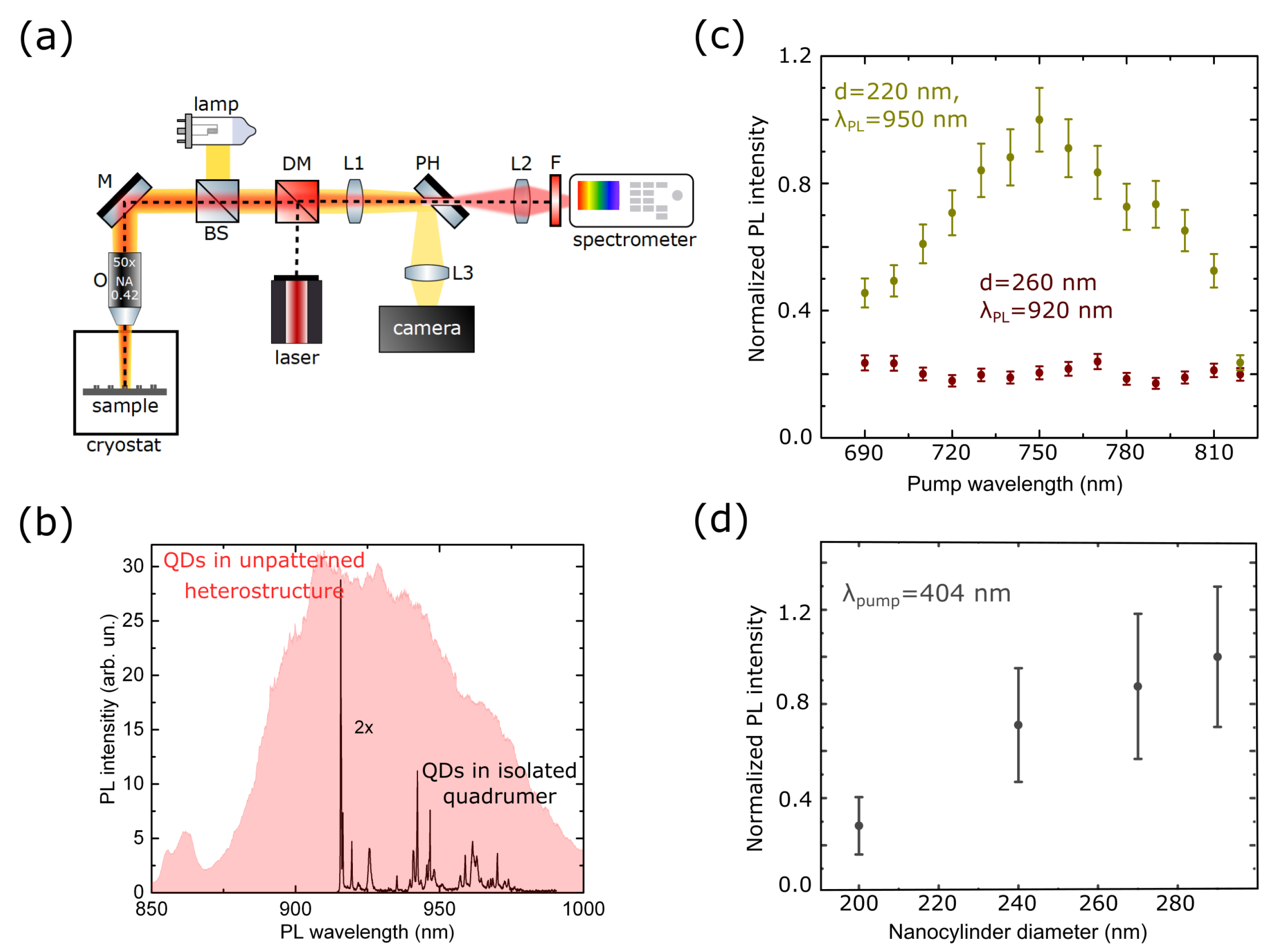Quantum Dot Photoluminescence Enhancement in GaAs Nanopillar Oligomers Driven by Collective Magnetic Modes
Abstract
1. Introduction
2. Materials and Methods
2.1. Sample Fabrication
2.2. Dark-Field Spectroscopy
2.3. Micro-PL Spectroscopy
3. Results and Discussion
4. Conclusions
Supplementary Materials
Author Contributions
Funding
Data Availability Statement
Acknowledgments
Conflicts of Interest
Abbreviations
| QDs | Quantum Dots |
| PL | Photoluminescence |
| LP | Linear Polarization |
| AP | Azimuthal Polarization |
| MDR | Magnetic Dipolar Mie-type Resonance |
References
- O’Brien, J.L. Optical quantum computing. Science 2007, 318, 1567–1570. [Google Scholar] [CrossRef] [PubMed]
- Eisaman, M.D.; Fan, J.; Migdall, A.; Polyakov, S.V. Invited review article: Single-photon sources and detectors. Rev. Sci. Instrum. 2011, 82, 071101. [Google Scholar] [CrossRef] [PubMed]
- Wang, H.; He, Y.; Li, Y.H.; Su, Z.E.; Li, B.; Huang, H.L.; Ding, X.; Chen, M.C.; Liu, C.; Qin, J.; et al. High-efficiency multiphoton boson sampling. Nat. Photonics 2017, 11, 361–365. [Google Scholar] [CrossRef]
- Hijlkema, M.; Weber, B.; Specht, H.P.; Webster, S.C.; Kuhn, A.; Rempe, G. A single-photon server with just one atom. Nat. Phys. 2007, 3, 253–255. [Google Scholar] [CrossRef]
- Keller, M.; Lange, B.; Hayasaka, K.; Lange, W.; Walther, H. Continuous generation of single photons with controlled waveform in an ion-trap cavity system. Nature 2004, 431, 1075–1078. [Google Scholar] [CrossRef]
- Lounis, B.; Moerner, W.E. Single photons on demand from a single molecule at room temperature. Nature 2000, 407, 491–493. [Google Scholar] [CrossRef] [PubMed]
- Kurtsiefer, C.; Mayer, S.; Zarda, P.; Weinfurter, H. Stable solid-state source of single photons. Phys. Rev. Lett. 2000, 85, 290. [Google Scholar] [CrossRef] [PubMed]
- Michler, P. Quantum Dots for Quantum Information Technologies; Springer: Berlin/Heidelberg, Germany, 2017; Volume 237. [Google Scholar]
- Shields, A.J. Semiconductor quantum light sources. In Nanoscience and Technology: A Collection of Reviews from Nature Journals; World Scientific: Singapore, 2010; pp. 221–229. [Google Scholar]
- Santori, C.; Fattal, D.; Yamamoto, Y. Single-Photon Devices and Applications; John Wiley & Sons: Hoboken, NJ, USA, 2010. [Google Scholar]
- Rakhlin, M.; Belyaev, K.; Klimko, G.; Mukhin, I.; Kirilenko, D.; Shubina, T.; Ivanov, S.; Toropov, A. InAs/AlGaAs quantum dots for single-photon emission in a red spectral range. Sci. Rep. 2018, 8, 5299. [Google Scholar]
- Rakhlin, M.; Belyaev, K.; Klimko, G.V.; Sedova, I.V.; Kulagina, M.M.; Zadiranov, Y.M.; Troshkov, S.; Guseva, Y.A.; Terent’ev, Y.V.; Ivanov, S.V.; et al. Highly efficient semiconductor emitter of single photons in the red spectral range. JETP Lett. 2019, 109, 145–149. [Google Scholar] [CrossRef]
- Leonard, D.; Krishnamurthy, M.; Reaves, C.; DenBaars, S.P.; Petroff, P.M. Direct formation of quantum-sized dots from uniform coherent islands of InGaAs on GaAs surfaces. Appl. Phys. Lett. 1993, 63, 3203–3205. [Google Scholar] [CrossRef]
- Hepp, S.; Jetter, M.; Portalupi, S.L.; Michler, P. Semiconductor quantum dots for integrated quantum photonics. Adv. Quant. Techn. 2019, 2, 1900020. [Google Scholar] [CrossRef]
- Yang, Y.; Zheng, Y.; Cao, W.; Titov, A.; Hyvonen, J.; Manders, J.R.; Xue, J.; Holloway, P.H.; Qian, L. High-efficiency light-emitting devices based on quantum dots with tailored nanostructures. Nat. Photonics 2015, 9, 259–266. [Google Scholar] [CrossRef]
- Pietryga, J.M.; Park, Y.S.; Lim, J.; Fidler, A.F.; Bae, W.K.; Brovelli, S.; Klimov, V.I. Spectroscopic and device aspects of nanocrystal quantum dots. Chem. Rev. 2016, 116, 10513–10622. [Google Scholar] [CrossRef]
- Ding, X.; He, Y.; Duan, Z.C.; Gregersen, N.; Chen, M.C.; Unsleber, S.; Maier, S.; Schneider, C.; Kamp, M.; Höfling, S.; et al. On-demand single photons with high extraction efficiency and near-unity indistinguishability from a resonantly driven quantum dot in a micropillar. Phys. Rev. Lett. 2016, 116, 020401. [Google Scholar] [CrossRef] [PubMed]
- Liu, S.; Wei, Y.; Su, R.; Su, R.; Ma, B.; Chen, Z.; Ni, H.; Niu, Z.; Yu, Y.; Wei, Y.; et al. A deterministic quantum dot micropillar single photon source with> 65% extraction efficiency based on fluorescence imaging method. Sci. Rep. 2017, 7, 1–7. [Google Scholar] [CrossRef] [PubMed]
- Ghulinyan, M.; Navarro-Urrios, D.; Pitanti, A.; Lui, A.; Pucker, G.; Pavesi, L. Whispering-gallery modes and light emission from a Si-nanocrystal-based single microdisk resonator. Opt. Express 2008, 16, 13218–13224. [Google Scholar] [CrossRef]
- Purcell, E.M. Spontaneous emission probabilities at radio frequencies. In Confined Electrons and Photons; Springer: Berlin/Heidelberg, Germany, 1995; p. 839. [Google Scholar]
- Somaschi, N.; Giesz, V.; De Santis, L.; Loredo, J.; Almeida, M.P.; Hornecker, G.; Portalupi, S.L.; Grange, T.; Anton, C.; Demory, J.; et al. Near-optimal single-photon sources in the solid state. Nat. Phot. 2016, 10, 340–345. [Google Scholar] [CrossRef]
- Ollivier, H.; Priya, P.; Harouri, A.; Sagnes, I.; Lemaître, A.; Krebs, O.; Lanco, L.; Lanzillotti-Kimura, N.; Esmann, M.; Senellart, P. Three-dimensional electrical control of the excitonic fine structure for a quantum dot in a cavity. Phys. Rev. Lett. 2022, 129, 057401. [Google Scholar] [CrossRef] [PubMed]
- Tomm, N.; Javadi, A.; Antoniadis, N.O.; Najer, D.; Löbl, M.C.; Korsch, A.R.; Schott, R.; Valentin, S.R.; Wieck, A.D.; Ludwig, A.; et al. A bright and fast source of coherent single photons. Nat. Nanotechnol. 2021, 16, 399–403. [Google Scholar] [CrossRef] [PubMed]
- Lodahl, P.; Mahmoodian, S.; Stobbe, S. Interfacing single photons and single quantum dots with photonic nanostructures. Rev. Mod. Phys. 2015, 87, 347. [Google Scholar] [CrossRef]
- Bozhevolnyi, S.I.; Khurgin, J.B. Fundamental limitations in spontaneous emission rate of single-photon sources. Optica 2016, 3, 1418–1421. [Google Scholar] [CrossRef]
- Bogdanov, S.I.; Boltasseva, A.; Shalaev, V.M. Overcoming quantum decoherence with plasmonics. Science 2019, 364, 532–533. [Google Scholar] [CrossRef] [PubMed]
- Kulakovich, O.; Strekal, N.; Yaroshevich, A.; Maskevich, S.; Gaponenko, S.; Nabiev, I.; Woggon, U.; Artemyev, M. Enhanced luminescence of CdSe quantum dots on gold colloids. Nano Lett. 2002, 2, 1449–1452. [Google Scholar] [CrossRef]
- Hoang, T.B.; Akselrod, G.M.; Mikkelsen, M.H. Ultrafast room-temperature single photon emission from quantum dots coupled to plasmonic nanocavities. Nano Lett. 2016, 16, 270–275. [Google Scholar] [CrossRef] [PubMed]
- Tsakmakidis, K.L.; Boyd, R.W.; Yablonovitch, E.; Zhang, X. Large spontaneous-emission enhancements in metallic nanostructures: Towards LEDs faster than lasers. Opt. Express 2016, 24, 17916–17927. [Google Scholar] [CrossRef]
- Russell, K.J.; Liu, T.L.; Cui, S.; Hu, E.L. Large spontaneous emission enhancement in plasmonic nanocavities. Nat. Photonics 2012, 6, 459–462. [Google Scholar] [CrossRef]
- Wein, S.; Lauk, N.; Ghobadi, R.; Simon, C. Feasibility of efficient room-temperature solid-state sources of indistinguishable single photons using ultrasmall mode volume cavities. Phys. Rev. B 2018, 97, 205418. [Google Scholar] [CrossRef]
- Wang, F.; Shen, Y.R. General properties of local plasmons in metal nanostructures. Phys. Rev. Lett. 2006, 97, 206806. [Google Scholar] [CrossRef]
- Hepp, S.; Bauer, S.; Hornung, F.; Schwartz, M.; Portalupi, S.L.; Jetter, M.; Michler, P. Bragg grating cavities embedded into nano-photonic waveguides for Purcell enhanced quantum dot emission. Opt. Express 2018, 26, 30614–30622. [Google Scholar] [CrossRef]
- Makhonin, M.N.; Dixon, J.E.; Coles, R.J.; Royall, B.; Luxmoore, I.J.; Clarke, E.; Hugues, M.; Skolnick, M.S.; Fox, A.M. Waveguide coupled resonance fluorescence from on-chip quantum emitter. Nano Lett. 2014, 14, 6997–7002. [Google Scholar] [CrossRef]
- Liu, F.; Brash, A.J.; O’Hara, J.; Martins, L.M.; Phillips, C.L.; Coles, R.J.; Royall, B.; Clarke, E.; Bentham, C.; Prtljaga, N.; et al. High Purcell factor generation of indistinguishable on-chip single photons. Nat. Nanotechnol. 2018, 13, 835–840. [Google Scholar] [CrossRef]
- Gartman, A.D.; Kroychuk, M.K.; Shorokhov, A.S.; Fedyanin, A.A. Efficient integration of single-photon emitters in thin InSe films into resonance silicon waveguides. JETP Lett. 2020, 112, 693–698. [Google Scholar] [CrossRef]
- Zhu, X.; Chass, G.A.; Kwek, L.C.; Rogach, A.L.; Su, H. Excitonic character in optical properties of tetrahedral CdX (X= S, Se, Te) clusters. J. Phys. Chem. C 2015, 119, 29171–29177. [Google Scholar] [CrossRef]
- Rakhlin, M.; Sorokin, S.; Kazanov, D.; Sedova, I.; Shubina, T.; Ivanov, S.; Mikhailovskii, V.; Toropov, A. Bright single-photon emitters with a CdSe quantum dot and multimode tapered nanoantenna for the visible spectral range. Nanomaterials 2021, 11, 916. [Google Scholar] [CrossRef] [PubMed]
- Tame, M.S.; McEnery, K.; Özdemir, Ş.; Lee, J.; Maier, S.A.; Kim, M. Quantum plasmonics. Nat. Phys. 2013, 9, 329–340. [Google Scholar] [CrossRef]
- Bermúdez-Urena, E.; Gonzalez-Ballestero, C.; Geiselmann, M.; Marty, R.; Radko, I.P.; Holmgaard, T.; Alaverdyan, Y.; Moreno, E.; García-Vidal, F.J.; Bozhevolnyi, S.I.; et al. Coupling of individual quantum emitters to channel plasmons. Nat. Commun. 2015, 6, 1–9. [Google Scholar] [CrossRef] [PubMed]
- Kuznetsov, A.I.; Miroshnichenko, A.E.; Fu, Y.H.; Zhang, J.; Luk’Yanchuk, B. Magnetic light. Sci. Rep. 2012, 2, 492. [Google Scholar] [CrossRef] [PubMed]
- Kruk, S.; Kivshar, Y. Functional meta-optics and nanophotonics governed by Mie resonances. ACS Photonics 2017, 4, 2638–2649. [Google Scholar] [CrossRef]
- Smirnova, D.; Kivshar, Y.S. Multipolar nonlinear nanophotonics. Optica 2016, 3, 1241–1255. [Google Scholar] [CrossRef]
- Bouchet, D.; Mivelle, M.; Proust, J.; Gallas, B.; Ozerov, I.; Garcia-Parajo, M.F.; Gulinatti, A.; Rech, I.; De Wilde, Y.; Bonod, N.; et al. Enhancement and inhibition of spontaneous photon emission by resonant silicon nanoantennas. Phys. Rev. Appl. 2016, 6, 064016. [Google Scholar] [CrossRef]
- Zalogina, A.S.; Savelev, R.; Ushakova, E.V.; Zograf, G.; Komissarenko, F.; Milichko, V.; Makarov, S.; Zuev, D.; Shadrivov, I. Purcell effect in active diamond nanoantennas. Nanoscale 2018, 10, 8721–8727. [Google Scholar] [CrossRef]
- Rutckaia, V.; Heyroth, F.; Novikov, A.; Shaleev, M.; Petrov, M.; Schilling, J. Quantum dot emission driven by Mie resonances in silicon nanostructures. Nano Lett. 2017, 17, 6886–6892. [Google Scholar] [CrossRef]
- Vaskin, A.; Bohn, J.; Chong, K.E.; Bucher, T.; Zilk, M.; Choi, D.Y.; Neshev, D.N.; Kivshar, Y.S.; Pertsch, T.; Staude, I. Directional and spectral shaping of light emission with Mie-resonant silicon nanoantenna arrays. ACS Photonics 2018, 5, 1359–1364. [Google Scholar] [CrossRef]
- Bohn, J.; Bucher, T.; Chong, K.E.; Komar, A.; Choi, D.Y.; Neshev, D.N.; Kivshar, Y.S.; Pertsch, T.; Staude, I. Active tuning of spontaneous emission by Mie-resonant dielectric metasurfaces. Nano Lett. 2018, 18, 3461–3465. [Google Scholar] [CrossRef] [PubMed]
- Muravitskaya, A.; Movsesyan, A.; Guzatov, D.V.; Baudrion, A.L.; Adam, P.M.; Gaponenko, S.V.; Vincent, R. Engineering of the Photon Local Density of States: Strong Inhibition of Spontaneous Emission near the Resonant and High-Refractive Index Dielectric Nano-objects. J. Phys. Chem. C 2022, 126, 5691–5700. [Google Scholar] [CrossRef] [PubMed]
- Obydennov, D.V.; Shilkin, D.A.; Elyas, E.I.; Yaroshenko, V.V.; Kudryavtsev, O.S.; Zuev, D.A.; Lyubin, E.V.; Ekimov, E.A.; Vlasov, I.I.; Fedyanin, A.A. Spontaneous Light Emission Assisted by Mie Resonances in Diamond Nanoparticles. Nano Lett. 2021, 21, 10127–10132. [Google Scholar] [CrossRef]
- Nieto-Vesperinas, M.; Gomez-Medina, R.; Saenz, J. Angle-suppressed scattering and optical forces on submicrometer dielectric particles. JOSA A 2011, 28, 54–60. [Google Scholar] [CrossRef]
- Staude, I.; Miroshnichenko, A.E.; Decker, M.; Fofang, N.T.; Liu, S.; Gonzales, E.; Dominguez, J.; Luk, T.S.; Neshev, D.N.; Brener, I.; et al. Tailoring directional scattering through magnetic and electric resonances in subwavelength silicon nanodisks. ACS Nano 2013, 7, 7824–7832. [Google Scholar] [CrossRef]
- Shilkin, D.A.; Lyubin, E.V.; Shcherbakov, M.R.; Lapine, M.; Fedyanin, A.A. Directional optical sorting of silicon nanoparticles. ACS Photonics 2017, 4, 2312–2319. [Google Scholar] [CrossRef]
- Gulkin, D.N.; Popkova, A.A.; Afinogenov, B.I.; Shilkin, D.A.; Kuršelis, K.; Chichkov, B.N.; Bessonov, V.O.; Fedyanin, A.A. Mie-driven directional nanocoupler for Bloch surface wave photonic platform. Nanophotonics 2021, 10, 2939–2947. [Google Scholar] [CrossRef]
- Shcherbakov, M.R.; Neshev, D.N.; Hopkins, B.; Shorokhov, A.S.; Staude, I.; Melik-Gaykazyan, E.V.; Decker, M.; Ezhov, A.A.; Miroshnichenko, A.E.; Brener, I.; et al. Enhanced third-harmonic generation in silicon nanoparticles driven by magnetic response. Nano Lett. 2014, 14, 6488–6492. [Google Scholar] [CrossRef] [PubMed]
- Hopkins, B.; Poddubny, A.N.; Miroshnichenko, A.E.; Kivshar, Y.S. Revisiting the physics of Fano resonances for nanoparticle oligomers. Phys. Rev. A 2013, 88, 053819. [Google Scholar] [CrossRef]
- Limonov, M.F.; Rybin, M.V.; Poddubny, A.N.; Kivshar, Y.S. Fano resonances in photonics. Nat. Phot. 2017, 11, 543–554. [Google Scholar] [CrossRef]
- Shorokhov, A.S.; Melik-Gaykazyan, E.V.; Smirnova, D.A.; Hopkins, B.; Chong, K.E.; Choi, D.Y.; Shcherbakov, M.R.; Miroshnichenko, A.E.; Neshev, D.N.; Fedyanin, A.A.; et al. Multifold enhancement of third-harmonic generation in dielectric nanoparticles driven by magnetic Fano resonances. Nano Lett. 2016, 16, 4857–4861. [Google Scholar] [CrossRef]
- Kroychuk, M.K.; Yagudin, D.F.; Shorokhov, A.S.; Smirnova, D.A.; Volkovskaya, I.I.; Shcherbakov, M.R.; Shvets, G.; Kivshar, Y.S.; Fedyanin, A.A. Tailored Nonlinear Anisotropy in Mie-Resonant Dielectric Oligomers. Adv. Opt. Mater. 2019, 7, 1900447. [Google Scholar] [CrossRef]
- Rutckaia, V.; Heyroth, F.; Schmidt, G.; Novikov, A.; Shaleev, M.; Savelev, R.S.; Schilling, J.; Petrov, M. Coupling of germanium quantum dots with collective sub-radiant modes of silicon nanopillar arrays. Acs Photonics 2020, 8, 209–217. [Google Scholar] [CrossRef]
- Kroychuk, M.K.; Shorokhov, A.S.; Yagudin, D.F.; Shilkin, D.A.; Smirnova, D.A.; Volkovskaya, I.; Shcherbakov, M.R.; Shvets, G.; Fedyanin, A.A. Enhanced nonlinear light generation in oligomers of silicon nanoparticles under vector beam illumination. Nano Lett. 2020, 20, 3471–3477. [Google Scholar] [CrossRef]
- Melik-Gaykazyan, E.V.; Shcherbakov, M.R.; Shorokhov, A.S.; Staude, I.; Brener, I.; Neshev, D.N.; Kivshar, Y.S.; Fedyanin, A.A. Third-harmonic generation from Mie-type resonances of isolated all-dielectric nanoparticles. Phil. Trans. R. Soc. A 2017, 375, 20160281. [Google Scholar] [CrossRef]




Disclaimer/Publisher’s Note: The statements, opinions and data contained in all publications are solely those of the individual author(s) and contributor(s) and not of MDPI and/or the editor(s). MDPI and/or the editor(s) disclaim responsibility for any injury to people or property resulting from any ideas, methods, instructions or products referred to in the content. |
© 2023 by the authors. Licensee MDPI, Basel, Switzerland. This article is an open access article distributed under the terms and conditions of the Creative Commons Attribution (CC BY) license (https://creativecommons.org/licenses/by/4.0/).
Share and Cite
Kroychuk, M.K.; Shorokhov, A.S.; Yagudin, D.F.; Rakhlin, M.V.; Klimko, G.V.; Toropov, A.A.; Shubina, T.V.; Fedyanin, A.A. Quantum Dot Photoluminescence Enhancement in GaAs Nanopillar Oligomers Driven by Collective Magnetic Modes. Nanomaterials 2023, 13, 507. https://doi.org/10.3390/nano13030507
Kroychuk MK, Shorokhov AS, Yagudin DF, Rakhlin MV, Klimko GV, Toropov AA, Shubina TV, Fedyanin AA. Quantum Dot Photoluminescence Enhancement in GaAs Nanopillar Oligomers Driven by Collective Magnetic Modes. Nanomaterials. 2023; 13(3):507. https://doi.org/10.3390/nano13030507
Chicago/Turabian StyleKroychuk, Maria K., Alexander S. Shorokhov, Damir F. Yagudin, Maxim V. Rakhlin, Grigorii V. Klimko, Alexey A. Toropov, Tatiana V. Shubina, and Andrey A. Fedyanin. 2023. "Quantum Dot Photoluminescence Enhancement in GaAs Nanopillar Oligomers Driven by Collective Magnetic Modes" Nanomaterials 13, no. 3: 507. https://doi.org/10.3390/nano13030507
APA StyleKroychuk, M. K., Shorokhov, A. S., Yagudin, D. F., Rakhlin, M. V., Klimko, G. V., Toropov, A. A., Shubina, T. V., & Fedyanin, A. A. (2023). Quantum Dot Photoluminescence Enhancement in GaAs Nanopillar Oligomers Driven by Collective Magnetic Modes. Nanomaterials, 13(3), 507. https://doi.org/10.3390/nano13030507






